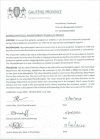Experiences and effects of telerehabilitation services for physiotherapy outpatients in a resource-constrained public health set-up in the backdrop of the COVID-19 pandemic: A proposal
- PMID: 34230898
- PMCID: PMC8252170
- DOI: 10.4102/sajp.v77i1.1528
Experiences and effects of telerehabilitation services for physiotherapy outpatients in a resource-constrained public health set-up in the backdrop of the COVID-19 pandemic: A proposal
Abstract
Background: The announcement of a national lockdown in South Africa had country-wide impact on the delivery of health services. Strategies included prioritisation of patients and protecting patients who were considered at risk, resulting in the need for cancellation and temporary termination of many outpatient therapy services. This necessitated the urgent need to come up with a way of delivering physiotherapy rehabilitation services to patients in a more non-traditional format. Telerehabilitation allows for the provision of services by using electronic communication, thus ensuring that patients are still able to access necessary rehabilitation services.
Methods/design: This is a prospective, mixed method study with participants recruited from the outpatient physiotherapy department of Chris Hani Baragwanath Academic Hospital (CHBAH). Telerehabilitation services will be provided via the patients' preferred method of communication. On discharge, participants and therapists will be asked about their experiences of telerehabilitation.
Discussion: Because of the current coronavirus disease 2019 (COVID-19) pandemic, patients are unable to receive traditional face-to-face physiotherapy services. Telerehabilitation offers a suitable alternative to treatment, but the feasibility, outcome and experiences of offering these services in the public health system have not been studied.
Conclusion: This study will determine whether telerehabilitation is a feasible service that can be offered in the COVID-19 pandemic, as well as post-pandemic, to enable physiotherapists to access those patients who are often unable to attend physiotherapy because of transport costs and various other reasons for non-attendance.
Clinical implications: The results of this study may indicate a way of managing patients in situations where face to face therapy cannot be undertaken.
Protocol identification: Pan African Clinical Trial Registry, PACTR202103637993156.
Keywords: COVID-19 pandemic; neuromusculoskeletal; orthopaedics; paediatrics; physiotherapy; telerehabilitation.
© 2021. The Authors.
Conflict of interest statement
The authors declare that they have no financial or personal relationships that may have inappropriately influenced them in writing this article.
Similar articles
-
Physiotherapists' perceptions of and willingness to use telerehabilitation in Kuwait during the COVID-19 pandemic.BMC Med Inform Decis Mak. 2021 Apr 8;21(1):122. doi: 10.1186/s12911-021-01478-x. BMC Med Inform Decis Mak. 2021. PMID: 33832473 Free PMC article.
-
What are the Perceptions and Lived Experiences of Canadian Injured Workers about the Provision of Physiotherapy Services using Telerehabilitation?J Occup Rehabil. 2024 Dec 15. doi: 10.1007/s10926-024-10261-4. Online ahead of print. J Occup Rehabil. 2024. PMID: 39674991
-
A survey of the experiences of delivering physiotherapy services through telerehabilitation during the COVID-19 pandemic.Front Rehabil Sci. 2024 Oct 24;5:1486801. doi: 10.3389/fresc.2024.1486801. eCollection 2024. Front Rehabil Sci. 2024. PMID: 39512760 Free PMC article.
-
Development and integration of telerehabilitation into service delivery and clinical training: A South African case study.In: Ernstzen DV, Jacobs-Nzuzi Khuabi LAJ, Bardien F, editors. Transformation of learning and teaching in rehabilitation sciences: A case study from South Africa [Internet]. Cape Town: AOSIS; 2022. Chapter 5. In: Ernstzen DV, Jacobs-Nzuzi Khuabi LAJ, Bardien F, editors. Transformation of learning and teaching in rehabilitation sciences: A case study from South Africa [Internet]. Cape Town: AOSIS; 2022. Chapter 5. PMID: 38446964 Free Books & Documents. Review.
-
Pulmonary Rehabilitation in a Post-COVID-19 World: Telerehabilitation as a New Standard in Patients with COPD.Int J Chron Obstruct Pulmon Dis. 2021 Feb 19;16:379-391. doi: 10.2147/COPD.S263031. eCollection 2021. Int J Chron Obstruct Pulmon Dis. 2021. PMID: 33642858 Free PMC article. Review.
Cited by
-
Perspectives of patients with osteoarthritis for using digital technology in rehabilitation at a public community centre in the Cape Metropole area: A qualitative study.Digit Health. 2024 Oct 1;10:20552076241282230. doi: 10.1177/20552076241282230. eCollection 2024 Jan-Dec. Digit Health. 2024. PMID: 39372806 Free PMC article.
-
Taking a Closer Look: "Evaluating Online Video Content for Rehabilitation after Distal Radius Fracture".J Clin Med. 2024 Aug 9;13(16):4691. doi: 10.3390/jcm13164691. J Clin Med. 2024. PMID: 39200833 Free PMC article.
-
A protocol for delivery of prehabilitation in lower limb arthroplasty in South Africa.S Afr J Physiother. 2025 Apr 8;81(1):2037. doi: 10.4102/sajp.v81i1.2037. eCollection 2025. S Afr J Physiother. 2025. PMID: 40357309 Free PMC article.
-
The effects of COVID-19 on the rehabilitation of persons with aphasia: A scoping review.S Afr J Commun Disord. 2022 Aug 4;69(2):e1-e9. doi: 10.4102/sajcd.v69i2.920. S Afr J Commun Disord. 2022. PMID: 36073071 Free PMC article.
References
LinkOut - more resources
Full Text Sources



